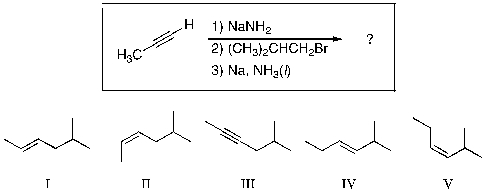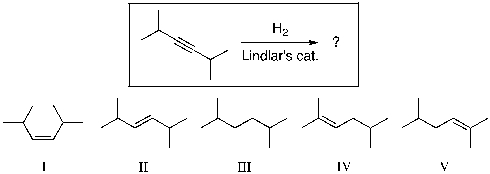Correct Answer

verified
(S)-2,3,6,6-tetramet...View Answer
Show Answer
Correct Answer
verified
View Answer
Multiple Choice
In a dissolving metal reduction of an alkyne, a postulated intermediate is the trans alkenyl radical, shown below. In which orbital type would the unpaired electron be located? 
A) sp
B) sp2
C) sp3
D) p
E) s
G) A) and C)
Correct Answer

verified
Correct Answer
verified
Multiple Choice
For the reaction shown, which of the compounds below would be the expected enol intermediate? 
A) I
B) II
C) III
D) IV
E) V
G) A) and D)
Correct Answer

verified
Correct Answer
verified
Short Answer
Provide the reagent(s) expected to accomplish the transformation shown below: 
Correct Answer

verified
Correct Answer
verified
Multiple Choice
What is the final major product expected for the following reaction sequence? 
A) (R) -3-chlorohexane
B) (S) -3-chlorohexane
C) meso-3,4-dichlorohexane
D) (±) -3,4-dichlorohexane
E) 2,3-dichloro-3-hexene
G) B) and E)
Correct Answer

verified
Correct Answer
verified
Multiple Choice
For the reaction shown, which of the compounds listed below would be the expected major, and final, organic product? 
A) I
B) II
C) III
D) IV
E) V
G) A) and E)
Correct Answer

verified
Correct Answer
verified
Multiple Choice
Select the reagent(s) expected to accomplish the transformation shown below. 
A) H2, Pd
B) H2, Lindlar's catalyst
C) Na, NH3(l)
D) A or B
E) B or C
G) B) and E)
Correct Answer

verified
Correct Answer
verified
Multiple Choice
For the reaction shown, which of the compounds below would be the expected major, and final, organic product? 
A) I
B) II
C) III
D) IV
E) V
G) D) and E)
Correct Answer

verified
Correct Answer
verified
Multiple Choice
Rank the following acids in order of decreasing acidity. 
A) V > I > IV > II > III
B) III > IV > II > I > V
C) V > I > III > II > IV
D) I > IV > V > II > III
E) IV > I > V > II > III
G) A) and D)
Correct Answer

verified
Correct Answer
verified
Multiple Choice
In an acid-catalyzed hydration, which of the following alkynes gives a single ketone?
A) 2-pentyne
B) 2-hexyne
C) 2-heptyne
D) 3-hexyne
E) 3-heptyne
G) None of the above
Correct Answer

verified
Correct Answer
verified
Essay
Draw all constitutional isomers of the molecular formula C6H10 that are internal alkynes.
Correct Answer

verified
Correct Answer
verified
Multiple Choice
What is the final major product expected for the following reaction sequence? 
A) I
B) II
C) III
D) IV
E) V
G) D) and E)
Correct Answer

verified
Correct Answer
verified
Multiple Choice
For the reaction shown, select the expected major organic product. 
A) I
B) II
C) III
D) IV
E) V
G) A) and C)
Correct Answer

verified
Correct Answer
verified
Multiple Choice
Which of the bases below would result in the most complete deprotonation of the alkyne, shown in the reaction below? 
A) NaOCH2CH3 (sodium ethoxide)
B) t-BuONa (sodium tert-butoxide)
C) NaH (sodium hydride)
D) NaHCO3 (sodium bicarbonate)
E) NaOH (sodium hydroxide)
G) B) and D)
Correct Answer

verified
Correct Answer
verified
Essay
Provide the structure(s) of the expected major organic product from the following reaction sequence: 
Correct Answer

verified
Correct Answer
verified
Multiple Choice
Which sequence of reactions is expected to produce the product below as the final, and major, organic product? 
A) 1) Br2; 2) H2, Lindlar's cat.
B) 1) H2, Lindlar's cat.; 2) Br2
C) 1) Br2; 2) Na, NH3(l)
D) 1) Na, NH3(l) ; 2) Br2
E) 1) Br2, 2) H2, Pt
G) A) and D)
Correct Answer

verified
Correct Answer
verified
Multiple Choice
What is the IUPAC name for the molecule shown below? 
A) 4-ethyl-2-pentyne
B) 2-ethyl-3-pentyne
C) 3-methyl-4-hexyne
D) 4-methyl-2-hexyne
E) sec-Butylpropyne
G) B) and D)
Correct Answer

verified
Correct Answer
verified
Multiple Choice
Which of the following statements is true about propyne, H-C≡C-CH3?
A) It contains a total of three sigma bonds.
B) It contains a total of three pi bonds.
C) The H-C≡C bond angle is about 109.5°.
D) The C≡C-C bond angle is 180°.
E) All carbon-carbon bonds are of equal length.
G) None of the above
Correct Answer

verified
Correct Answer
verified
Multiple Choice
Select the best reagent to convert 3-heptyne to trans-3-heptene?
A) Na/NH3
B) 1 eq. NaNH2, NH3
C) xs NaNH2, NH3
D) H2/Pt
E) H2/Lindlar's catalyst
G) B) and E)
Correct Answer

verified
Correct Answer
verified
Multiple Choice
Which of the following is the structure for 3-sec-butyl-1-heptyne? 
A) I
B) II
C) III
D) IV
E) V
G) D) and E)
Correct Answer

verified
Correct Answer
verified
Showing 121 - 140 of 166
Related Exams